实验1
实验任务1
task1_1.py
实验代码:
#用法1 print('hey, u') #用法2 print('hey','u') x, y, z = 1, 2, 3 print(x, y, z) #用法3 print('x = %d, y = %d, z = %d'%(x, y, z)) print('x = {}, y = {}, z = {}'.format(x, y, z)) print(f'x = {x}, y = {y}, z = {z}') #其他 print(x) print(y) print(z) print(x, end=' ') print(y, end=' ') print(z)
实验结果截图:

task1_2.py
实验代码:
x1, y1 = 1.2, 3.57 x2, y2 = 2.26, 8.7 #输出1 print('{:-^40}'.format('输出1')) print('x1 = {}, y1 = {}'.format(x1, y1)) print('x2 = {}, y2 = {}'.format(x2, y2)) #输出2 print('{:-^40}'.format('输出2')) print('x1 = {:.1f}, y1 = {:.1f}'.format(x1, y1)) print('x2 = {:.1f}, y2 = {:.1f}'.format(x2, y2)) #输出3 print('{:-^40}'.format('输出3')) print('x1 = {:<15.1f}, y1 = {:<15.1f}'.format(x1, y1)) print('x2 = {:<15.1f}, y2 = {:<15.1f}'.format(x2, y2)) #输出4 print('{:-^40}'.format('输出4')) print('x1 = {:>15.1f}, y1 = {:>15.1f}'.format(x1, y1)) print('x2 = {:>15.1f}, y2 = {:>15.1f}'.format(x2, y2))
实验结果截图:
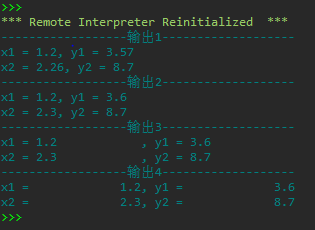
task1_3.py
实验代码:
name1, age1 = 'Bill', 19 name2, age2 = 'Hellen', 18 title = 'Personnel Information' print(f'{title:=^40}') print(f'name: {name1:10} age: {age1:3}') print(f'name: {name2:10} age: {age2:3}') print(40*'=')
实验结果截图:

实验总结:print()用于输出的几种常用用法
1.用于输出单个字符串或单个变量
2.用于输出多个数据项,用逗号分隔
3.用户混合字符串和变量值
4.输出后是否换行
实验任务2
task2_1.py
实验代码:
r1 = eval('1 + 2') print(type(r1), r1) r2 = eval('1 + 2j') print(type(r2), r2) r3 = eval('"python"') print(type(r3), r3) r4 = eval('7, 42') print(type(r4), r4)
实验结果截图:

task2_2.py
实验代码:
x, y = eval(input('Enter two oprands: ')) # 输入的两个操作数之间用逗号分隔(英文半角输入法下的逗号) ans = x + y print(f'{x} + {y} = {ans}') print(f'{type(x)} + {type(y)} = {type(ans)}')
实验结果截图:
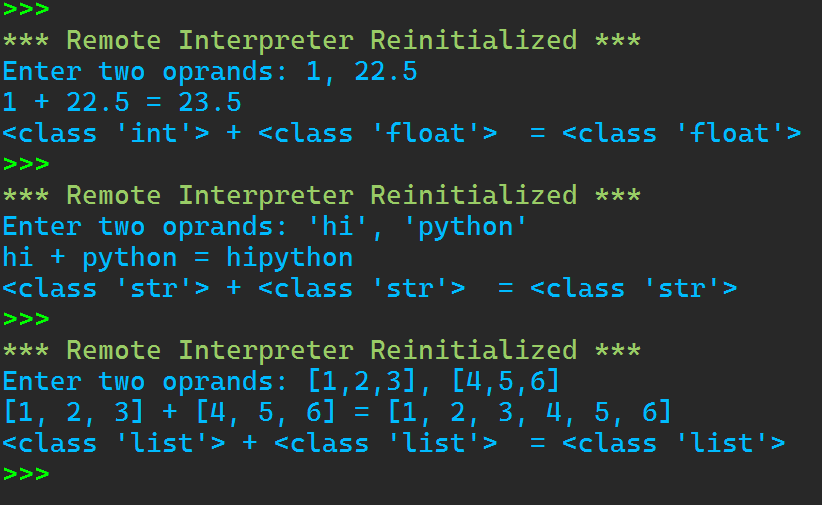
实验总结:函数eval()的用法
1.把字符串转化为python表达式
2.与input()函数组合使用
实验任务3
task3.py
实验代码:
ans1 = 0.1 + 0.2 print(f'0.1 + 0.2 = {ans1}') import decimal ans2 = decimal.Decimal('0.1') +decimal.Decimal('0.2') print(f'0.1 + 0.2 = {ans2}')
实验结果截图:

实验总结:
为什么前一种出现误差:因为计算机以二进制方式存储数据,对于小数的运算有误差
实验任务4
task4.py
实验代码:
print(chr(0x1f600), end = " ") print(chr(0x1f601), end = " ") print(chr(0x1f602), end = " ") print(chr(0x1f603), end = " ") print(chr(0x1f604)) print(chr(10000), end= " ") print(chr(0x025b), end= " ") print(chr(0x2708), end= " ") print(chr(0x00A5), end= " ") print(chr(0x266b)) print(ord('a'), end = " ") print(ord('b'), end = " ") print(ord('c')) print(ord('A'), end = " ") print(ord('B'), end = " ") print(ord('C')) print(ord('0'), end = " ") print(ord('1'), end = " ") print(ord('2'))
实验结果截图:
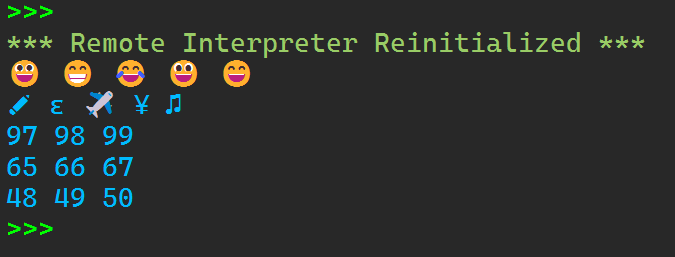
实验总结:函数chr()和ord()的用法
1.chr()返回unicode编码对应的字符
2.ord()返回字符的unicode编码
实验任务5
task5_1.py
实验代码:
import math n = float(input('输入一个数:')) ans1 = n**0.5 ans2 = pow(n, 0.5) ans3 = math.sqrt(n) print('%.2f的平方根是: %.2f' %(n, ans1)) print('{:.2f}的平方根是: {:.2f}'.format(n, ans2)) print(f'{n:.2f}的平方根是: {ans3:.2f}')
实验结果截图:
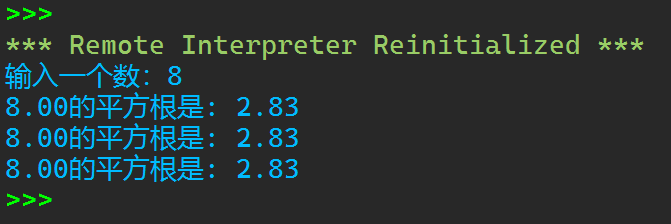
task5_2.py
实验代码:
import math text = ''' 好奇心是人的天性 理想状况下,学习新东西是让人愉快的事。 但学校里的学习似乎有点像苦役。 有时候,需要画一个大饼,每次尝试学一些新鲜的,才会每天变得更好一点点。 ''' print(text) r = float(input('给学习画一个大饼,大饼要做得很大,半径要这么大:')) circle = 2*math.pi*r print(f'绕起来,大饼的圆周有这么长,{circle}, 够不够激发你探索未知的动力...')
实验结果截图:

实验任务6
task6.py
实验代码:
x = eval(input('输入一个在集合{1.0, 1.01, 0.99}之间的数')) y = x**365 print(f'{x:.2f}的365次方:{y:.2f}')
实验结果截图:
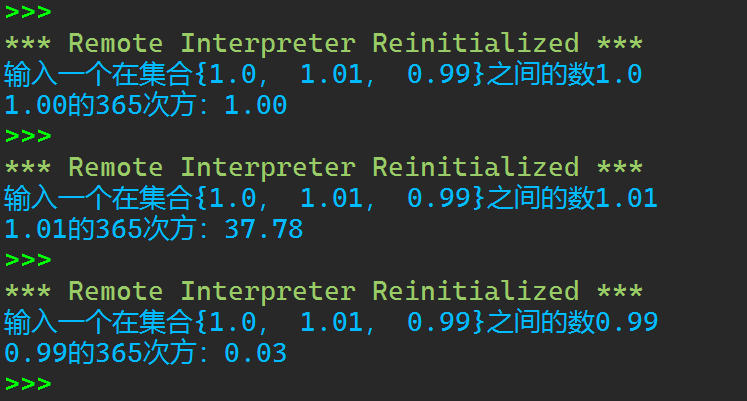
实验任务7
task7.py
实验代码:
from math import pi p = 1.038 c = 3.7 K = 5.4*10**(-3) M = 67 Tw = 100 Ty = 70 T0 = eval(input('请输入温度:')) import math t = (M**(2/3)*c*p**(1/3))/(K*pi**2*(4*pi/3)**(2/3))*math.log(0.76*(T0-Tw)/(Ty-Tw),math.e) a = int(t//60) b = int(t%60) print('T0=',T0,'℃,t=',a,'分',b,'秒')
实验结果截图:
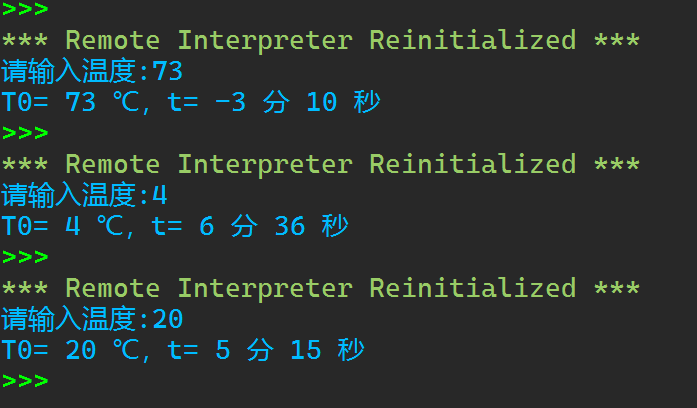
实验任务8
task8_1.py
实验代码:
""" 家用电器销售系统 v1.0 """ #欢迎信息 print('欢迎使用家用电器销售系统!') #产品信息列表 print('产品和价格信息如下: ') print('***********************************************************') print('%-10s'%'编号','%-10s'%'名称','%-10s'%'品牌','%-10s'%'价格','%-10s'%'库存数量') print('-----------------------------------------------------------') print('%-10s'%'0001','%-10s'%'电视机','%-10s'%'海尔','%10.2f'%5900.00,'%10d'%20) print('%-10s'%'0002','%-10s'%'冰箱','%-10s'%'西门子','%10.2f'%6998.00,'%10d'%15) print('%-10s'%'0003','%-10s'%'洗衣机','%-10s'%'小天鹅','%10.2f'%1900.00,'%10d'%10) print('%-10s'%'0004','%-10s'%'空调','%-10s'%'格力','%10.2f'%3900.00,'%10d'%0) print('%-10s'%'0005','%-10s'%'热水器','%-10s'%'美的','%10.2f'%688.00,'%10d'%30) print('%-10s'%'0006','%-10s'%'笔记本','%-10s'%'联想','%10.2f'%5699.00,'%10d'%10) print('%-10s'%'0007','%-10s'%'微波炉','%-10s'%'苏泊尔','%10.2f'%480.50,'%10d'%33) print('%-10s'%'0008','%-10s'%'投影仪','%-10s'%'松下','%10.2f'%1250.00,'%10d'%12) print('%-10s'%'0009','%-10s'%'吸尘器','%-10s'%'飞利浦','%10.2f'%999.00 ,'%10d'%9) print('-----------------------------------------------------------') #用户输入信息 product_id=input('请输入您要购买的产品编号:') price=float(input('请输入您要购买的产品价格:')) count=int(input('请输入您要购买的产品数量:')) #计算金额 print('购买成功,您需要支付',price*count,'元') #退出系统 print('谢谢您的光临,下次再见!')
实验结果截图:
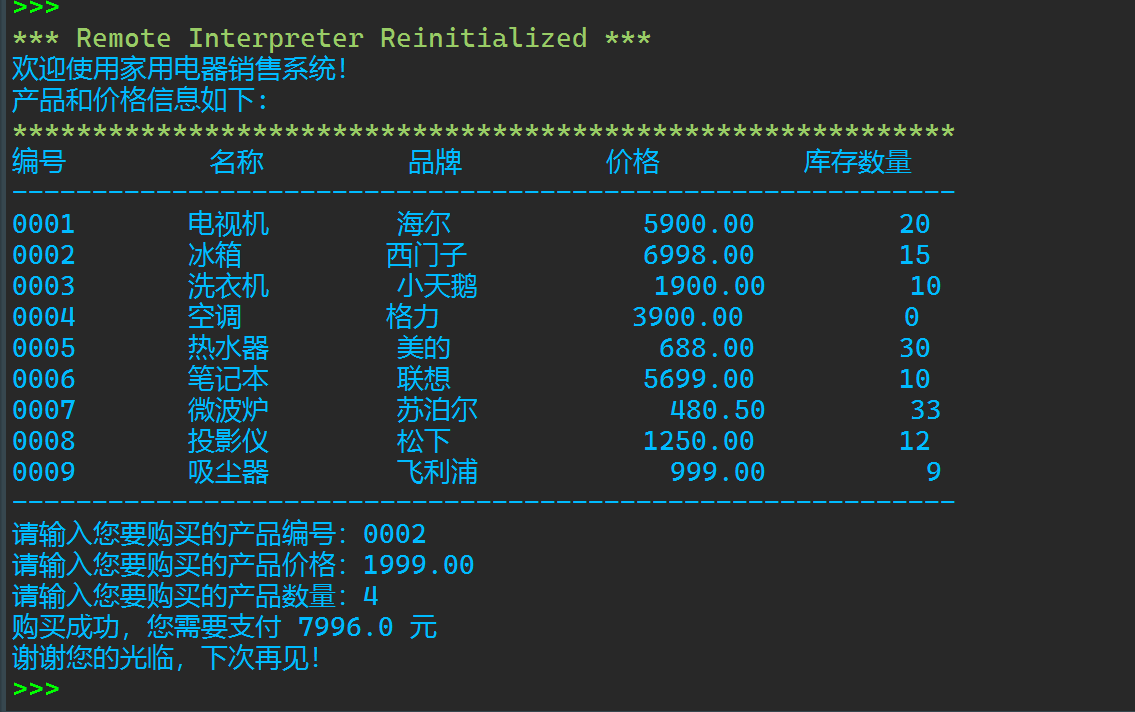
task8_2.py
实验代码:
""" 家用电器销售系统 v1.0 """ #欢迎信息 print('欢迎使用家用电器销售系统!') #产品信息列表 print('产品和价格信息如下: ') print('***********************************************************') print('{:<10}'.format('编号'),'{:<10}'.format('名称'),'{:<10}'.format('品牌'),'{:<10}'.format('价格'),'{:<10}'.format('库存数量')) print('---------------------------------------------------------------------') print('{:<10}'.format('0001'),'{:<10}'.format('电视机'),'{:<10}'.format('海尔'),'{:<10.2f}'.format(5999.00),'{:>10}'.format(20)) print('{:<10}'.format('0002'),'{:<10}'.format('冰箱'),'{:<10}'.format('西门子'),'{:<10.2f}'.format(6998.00),'{:>10}'.format(15)) print('{:<10}'.format('0003'),'{:<10}'.format('洗衣机'),'{:<10}'.format('小天鹅'),'{:<10.2f}'.format(1999.00),'{:>10}'.format(10)) print('{:<10}'.format('0004'),'{:<10}'.format('空调'),'{:<10}'.format('格力'),'{:<10.2f}'.format(3900.00),'{:>10}'.format(0)) print('{:<10}'.format('0005'),'{:<10}'.format('热水器'),'{:<10}'.format('美的'),'{:<10.2f}'.format(688.00),'{:>10}'.format(30)) print('{:<10}'.format('0006'),'{:<10}'.format('笔记本'),'{:<10}'.format('联想'),'{:<10.2f}'.format(5699.00),'{:>10}'.format(10)) print('{:<10}'.format('0007'),'{:<10}'.format('微波炉'),'{:<10}'.format('苏泊尔'),'{:<10.2f}'.format(480.50),'{:>10}'.format(33)) print('{:<10}'.format('0008'),'{:<10}'.format('投影仪'),'{:<10}'.format('松下'),'{:<10.2f}'.format(1250.00),'{:>10}'.format(12)) print('{:<10}'.format('0009'),'{:<10}'.format('吸尘器'),'{:<10}'.format('飞利浦'),'{:<10.2f}'.format(999.00),'{:>10}'.format(9)) print('-----------------------------------------------------------') #用户输入信息 product_id=input('请输入您要购买的产品编号:') price=float(input('请输入您要购买的产品价格:')) count=int(input('请输入您要购买的产品数量:')) #计算金额 print('购买成功,您需要支付',price*count,'元') #退出系统 print('谢谢您的光临,下次再见!')
实验结果截图:
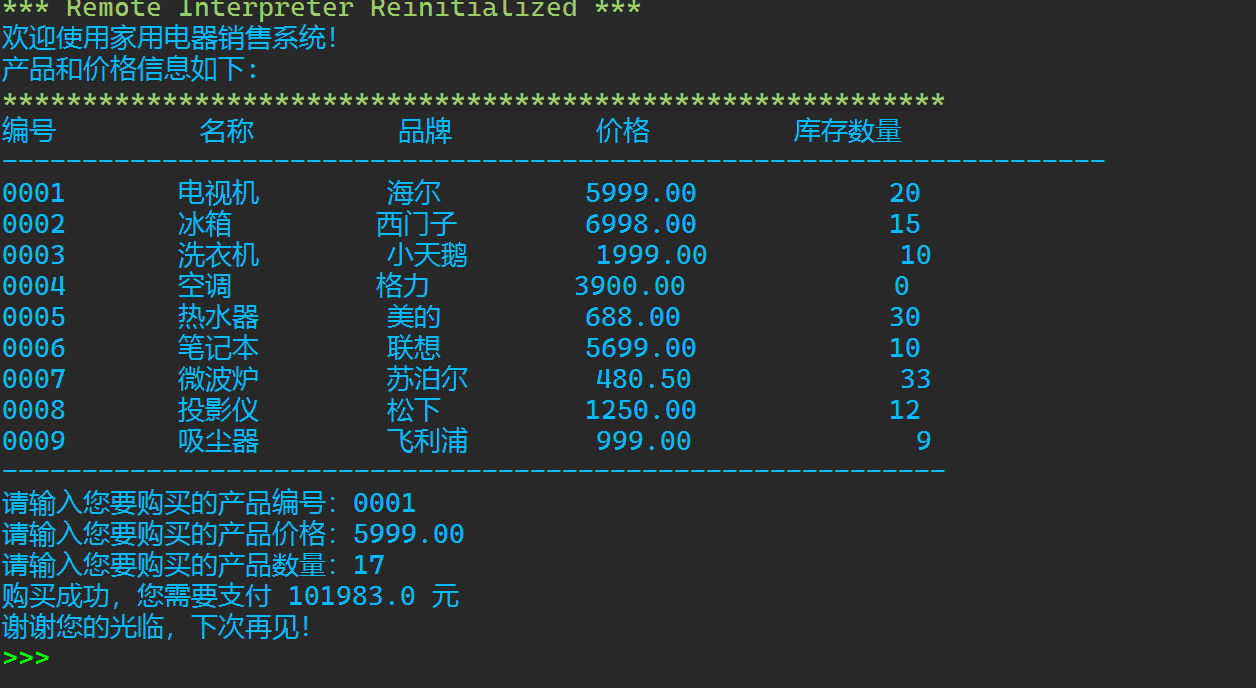
task8_3.py
实验代码:
""" 家用电器销售系统 v1.0 """ #欢迎信息 print('欢迎使用家用电器销售系统!') #产品信息列表 print('产品和价格信息如下: ') print('***********************************************************') a = ['编号','名称','品牌','价格','库存数量'] b = ["0001","0002","0003","0004","0005","0006","0007","0008","0009"] c = ['电视机','冰箱','洗衣机','空调','热水器','笔记本','微波炉','投影仪','吸尘器'] d = ['海尔','西门子','小天鹅','格力','美的','联想','苏泊尔','松下','飞利浦'] e = [5999.00,6998.00,1999.00,3900.00,688.00,5699.00,480.50,1250.00,999.00] f = [20,15,10,0,30,10,33,12,9] print(f'{a[0]:10s}{a[1]:10s}{a[2]:10s}{a[3]:10s}{a[4]:10s}') print('-----------------------------------------------------------') print(f'{b[0]:10s}{c[0]:10s}{d[0]:10s}{e[0]:10.2f}{f[0]:10d}') print(f'{b[1]:10s}{c[1]:10s}{d[1]:10s}{e[1]:10.2f}{f[1]:10d}') print(f'{b[2]:10s}{c[2]:10s}{d[2]:10s}{e[2]:10.2f}{f[2]:10d}') print(f'{b[3]:10s}{c[3]:10s}{d[3]:10s}{e[3]:10.2f}{f[3]:10d}') print(f'{b[4]:10s}{c[4]:10s}{d[4]:10s}{e[4]:10.2f}{f[4]:10d}') print(f'{b[5]:10s}{c[5]:10s}{d[5]:10s}{e[5]:10.2f}{f[5]:10d}') print(f'{b[6]:10s}{c[6]:10s}{d[6]:10s}{e[6]:10.2f}{f[6]:10d}') print(f'{b[7]:10s}{c[7]:10s}{d[7]:10s}{e[7]:10.2f}{f[7]:10d}') print(f'{b[8]:10s}{c[8]:10s}{d[8]:10s}{e[8]:10.2f}{f[8]:10d}') print('-----------------------------------------------------------') #用户输入信息 product_id=input('请输入您要购买的产品编号:') price=float(input('请输入您要购买的产品价格:')) count=int(input('请输入您要购买的产品数量:')) #计算金额 print('购买成功,您需要支付',price*count,'元') #退出系统 print('谢谢您的光临,下次再见!')
实验结果截图:
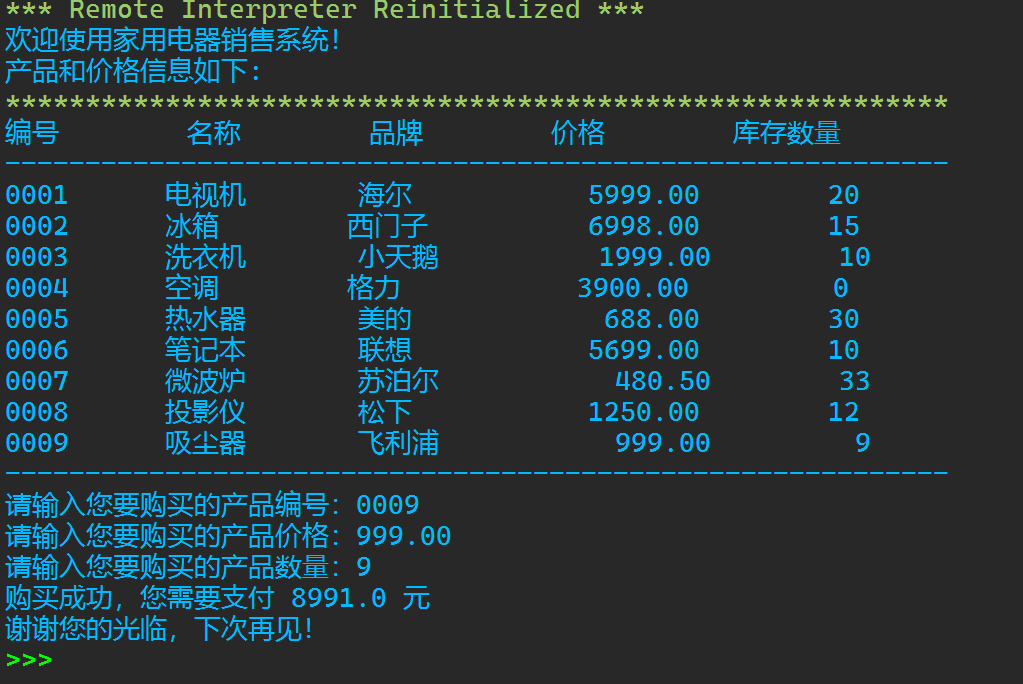


 浙公网安备 33010602011771号
浙公网安备 33010602011771号